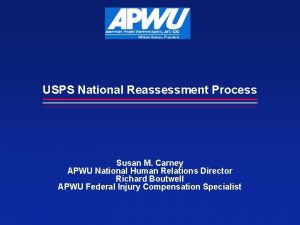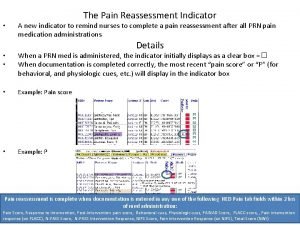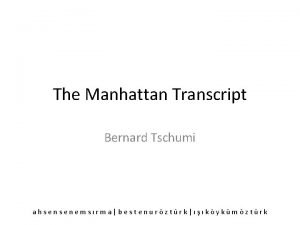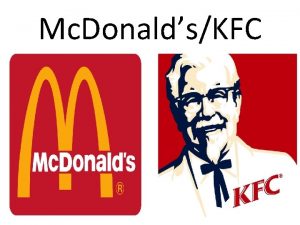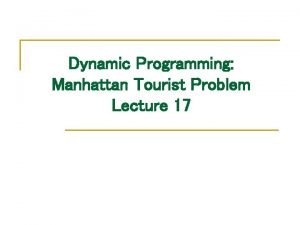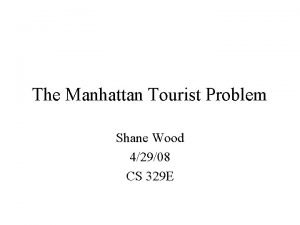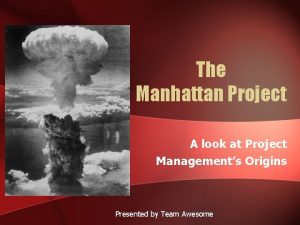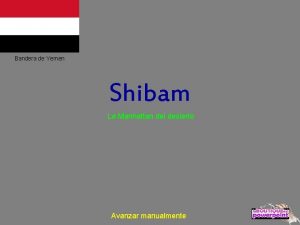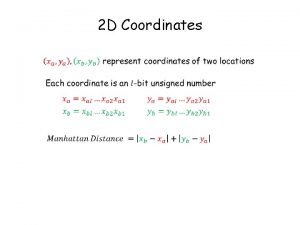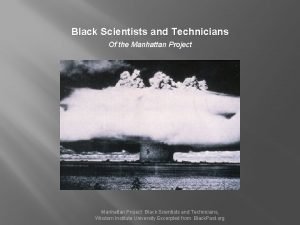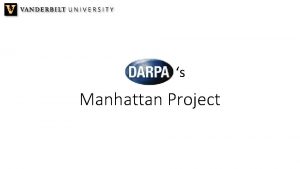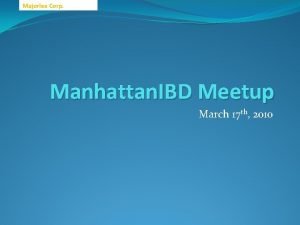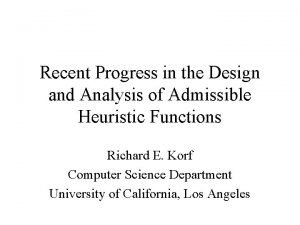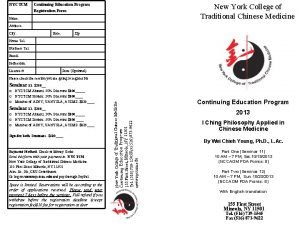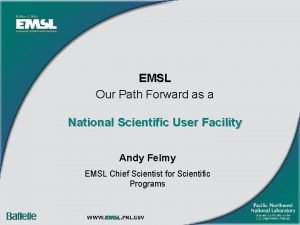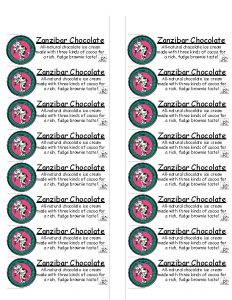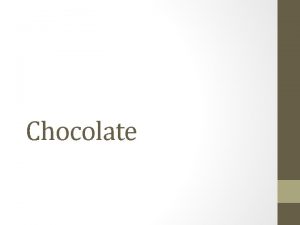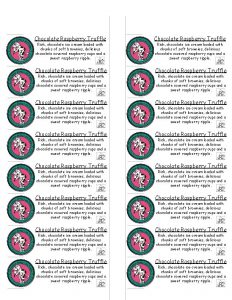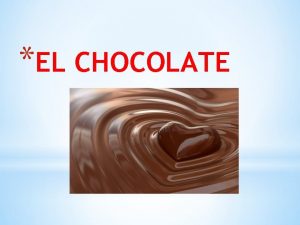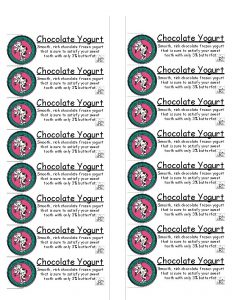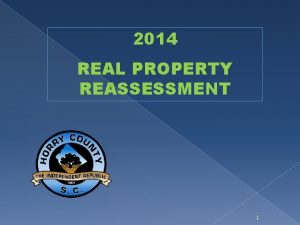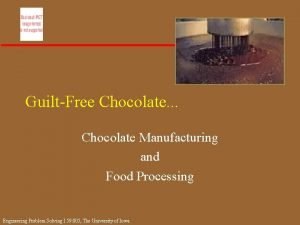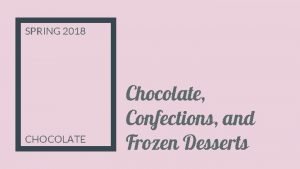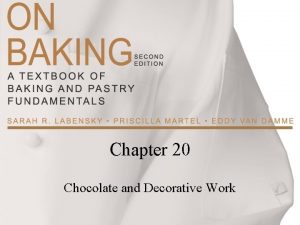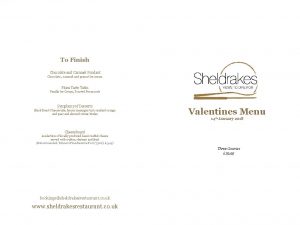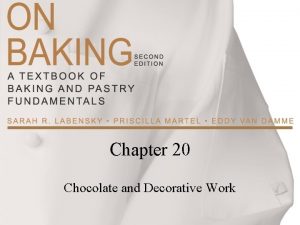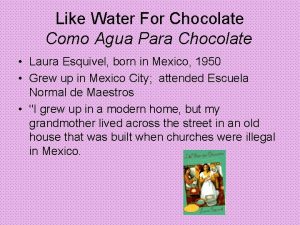MANHATTAN CHOCOLATE SOCIETY Reassessment of Goals Structure and





















- Slides: 21

MANHATTAN CHOCOLATE SOCIETY Reassessment of Goals, Structure and Focus. January 2020 1

AGENDA TOPIC PAGE Mission of the Manhattan Chocolate Society (Past, Present and Future) 3 -4 Current Membership 5 Organizational Structure 6 Review of Favorite/Least Favorite MCS tastings 7 Defining a Focused Tasting 7 Standardized Process for Creating an Event 9 Future Tasting Ideas 10 Notes/Next Steps 11 Addendums 12 -20 2

• Personal Enjoyment • Learn together as a group • Analytical approach to effects of terroir, post harvest, manufacturing etc. • Menu focus is plain, dark, craft chocolate Future • Personal Enjoyment • Learn together as a group • Basic exploration of brands, origins, and bean types • Menu focus is plain, dark, craft chocolate Present Past MISSION OF THE MANHATTAN CHOCOLATE SOCIETY • To be decided. • SUGGESTIONS • Build specific skills • Become expert tasters • Community outreach • Certification • Publication • Online Presence • Consulting 3

4

CURRENT MEMBERSHIP Membership: by invitation, limited core membership due to practicality and expenses PAST • Alexandra Leaf • Andrea Brelinski • Brady Brelinski • David Arnold • George Gensler • Ivo Turkedjiev • Matt Frederick • Rumi Turkedjiev PRESE NT • Alexandra Leaf • Brady Brelinski • David Arnold • George Gensler • Matt Frederick FUTUR E • Alexandra Leaf • Brady Brelinski • David Arnold • George Gensler • Matt Frederick 5

ORGANIZATIONAL STRUCTURE Are any changes needed to the organizational structure? q Decision making § See page 9 for recommendation. q Funding § What gets reimbursed and how? q Meeting location § Open discussion. q Guests § Regular guests that fit well in any focused tasting? § Guests only for specific focus? q Membership § Are new members needed? 6

REVIEW OF BEST/WORST MCS TASTINGS Review the MCS Record of Events page online and find 3 -5 tastings that you really liked and discuss why you liked them. Then identify 3 -5 tastings that did not goes as well, or you would do differently and discuss why you feel that way. FAVORITES LEAST FAVORITES 1 1 2 2 3 3 4 4 5 5 7

Four PILLARS of a Focused Tasting Four Pillars Objective § 1 -2 specific objectives written and communicated to team. Plan § Preplanning of all the particulars (attendees, date, time, location, menu, invitations, supplies, format, expenses etc. ) Menu § Identifying and securing a menu that directly supports the objectives. Resource § Identifying a resource (tasting method, video, book, chocolate maker, author, etc. ) that will provide the education. 8

MANHATTAN CHOCOLATE SOCIETY’S FOUR PILLARS OF A FOCUSED TASTING Objective Plan Menu § Identify 1 -2 specific objectives and communicate them to the group prior to the event. § Plan all the necessary details such as attendees, date, time, location, menu, invitations, supplies, format, expenses, etc. § Curate a menu wherein each bar directly supports the objective(s). § Determine specific method of educating the group that will facilitate meeting the objective. Resource

STANDARDIZING PROCESS FOR A MCS TASTING Purpose of standardizing the MCS Process: • Ensuring members find value from the tastings that will facilitate longevity of the group. • Ensure guests get a positive impression. MCS Founding Member Identifies tasting idea. Member communicates via email or in person with entire group to solicit interest followed by an email of a detailed plan if group is interested. Two members sign off that the tasting meets the pillars of a focused tasting and the mission of the Manhattan Chocolate Society. Once the tasting is approved the organizing member can email group for potential dates followed by a finalized invitation to all invited guests. 10

FUTURE TASTING IDEAS q Cocoaroma q Creation of Style Categories q Rustic, French, Consistent/Commercial (4+ingredients), Creative/Nouveau (3 ingredient), Unintentional (poor execution resulting in an unintentional secondary style) q Beyond Lexicon § Use of imagery such as drawings or photos that describe the bar § Discussion of individual process. Bring in an image that represents your process. q Sommelier Format § Blind- guess origin, fermentation, climate, equipment, roast, conche, recipe (two captains prepare menu so all can experience the blind) q Compare a 3 -5 sentence tasting note using a lexicon from a wheel or grid v. using a box of crayons to draw an impression of the chocolate from aroma to finish. q Value- Best low cost $2 -$3 bars. This could be done in any price range q Under ripe, Over ripe, under fermented, over fermented and just right bar comparisons. Would require us to work with a talented maker who has field access. Goal of finding those 4 under and over flavors. q 3 tastings- What would an MCS tasting be for the general public? a group of chocolate retailers? chocolate tasters with lots of experience? q Design the perfect bar. This could be two part. 1 st what do we like the most in a bar? 2 nd work with a talented maker to put in a bar or bars what we think might be the ultimate bar. q Brut or rough bar tasting. What works or doesn't? q Cocoa butter tasting with bars made from those butters. We could work this backwards and ask makers for a tiny sample of the butter they use in the bars we want to try. q Hot chocolate tasting. Perhaps all water only. q Aging chocolate. A comparison. q The other Theobromas. Grandiflorum and Bicolor. q One (or several) chocolate(s) with different amounts of cocoa butter. None, %5, %10, %20? Does it change all origins the same way? 11

NOTES/ NEXT STEPS 12

ADDENDUMS TOPIC PAGE Learning to Become an Expert Taster 13 Tips for Maintaining a Successful Tasting Group 14 Wine Sommelier Tasting Grid 15 Beer Tasting Grid 16 Coffee Cupping Grids 17 -20 13

PURPOSE OF MANHATTAN CHOCOLATE SOCIETY LEARNING TO BECOME AN EXPERT TASTER (HARVARD BUSINESS SCHOOL) Three Stage Process of Learning: 1. Unstructured Novice Stage: q Somewhat holistic approach but very naively. 2. Enthusiast Stage: q Analytic processing. q Adoption of a lexicon (from a tasting wheel or grid) which can lead to a better memory for an otherwise ambiguous experience and increase in familiarity. However regurgitating textbook stuff can be the limiting factor and decreased the meaning and learning potential. 3. Expert Stage: q Holistic processing, independent from lexicon, able to use nonverbal evaluation of experience to appreciate the whole experience. Improves memory of experience. Uses images rather than words. q Master sommelier diploma is the highest distinction a professional can attain in fine wine and beverage service. q Currently their are only 229 people with this distinction. 14

TIPS FOR MAINTAINING A SUCCESSFUL TASTING GROUP (ADVICE FROM MASTER SOMMELIER'S): q Regular reflection and reevaluation q Determine the tasting format the meets the needs of the group (Ex. blind flight, etc. ) q Explore new formats that build skills (Ex. assign members different aspects of the tasting. One person assesses only the aroma, another the texture, another the flavor, etc. ) q Designate a leader or use a captain/co-captain system q Prepare some theory questions to bring to the tasting q Discuss options for dealing with tasting costs (keep a chocolate cellar for future tastings, prepay via Venmo) q Vet menu items ahead of time so everything makes sense and is up to snuff q Consider the optimum size for the group § costs can be spread across larger group sizes allowing for more expensive menu § larger groups make organizing events more challenging and require more supplies § larger groups have more problems with punctuality § smaller groups of 5 to 6 can be more productive and powerful. small means that everyone has a voice, not much opportunity to hide or timid. with 5 or 6 people there is still enough people to allow for diversity of experience and conflicting notes that allow for deeper levels of learning. q Foster respect- tone of the group should be supportive and allow feedback and constructive criticism from members without members taking the feedback or criticism personally 15

FUTURE TASTING IDEAS- BASED ON WINE SOMM TASTING GRID 16

FUTURE TASTING IDEASBASED ON BEER TASTING GRID 17

FUTURE TASTING IDEAS- BASED ON COFFEE CUPPING LIN K 18

FUTURE TASTING IDEAS- BASED ON COFFEE CUPPING 19

FUTURE TASTING IDEAS- BASED ON COFFEE CUPPING 20

FUTURE TASTING IDEAS- BASED ON COFFEE CUPPING 21
 Strategic goals tactical goals operational goals
Strategic goals tactical goals operational goals Strategic goals tactical goals operational goals
Strategic goals tactical goals operational goals National reassessment process
National reassessment process Ihss annual reassessment
Ihss annual reassessment Andicator
Andicator What chocolate melts the fastest
What chocolate melts the fastest General goals and specific goals
General goals and specific goals Motivation in consumer behaviour
Motivation in consumer behaviour Manhattan transcript
Manhattan transcript Kfc manhattan
Kfc manhattan Manhattan problem
Manhattan problem Manhattan tourist problem
Manhattan tourist problem Manhattan project management
Manhattan project management Manhattan del desierto
Manhattan del desierto Manhattan distance formula
Manhattan distance formula Jesse ernest wilkins jr
Jesse ernest wilkins jr Manhattan tutorial
Manhattan tutorial Meetup manhattan
Meetup manhattan Manhattan distance
Manhattan distance New york college of traditional chinese medicine mineola
New york college of traditional chinese medicine mineola Emsl calgary
Emsl calgary Torrance memorial hospital medical records
Torrance memorial hospital medical records


